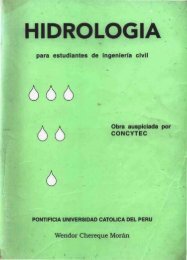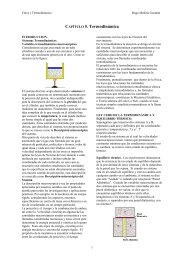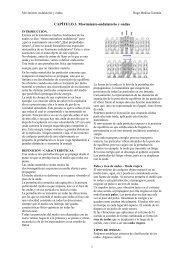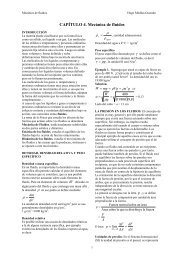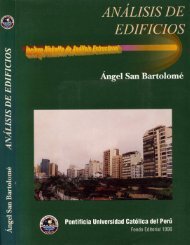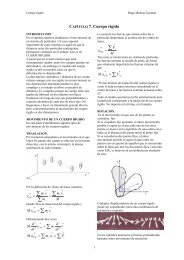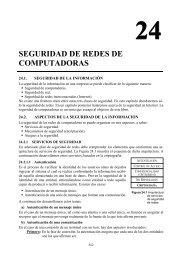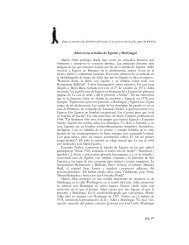CAPÍTULO 4. Dinámica de una partícula - Biblioteca
CAPÍTULO 4. Dinámica de una partícula - Biblioteca
CAPÍTULO 4. Dinámica de una partícula - Biblioteca
You also want an ePaper? Increase the reach of your titles
YUMPU automatically turns print PDFs into web optimized ePapers that Google loves.
<strong>Dinámica</strong> <strong>de</strong> <strong>una</strong> <strong>partícula</strong> Hugo Medina Guzmán<br />
( 3 cos − 2)<br />
= 0<br />
N = mg θ<br />
2<br />
⇒ cos θ = ⇒ θ = 48,19º<br />
3<br />
Ejemplo 47. En un parque <strong>de</strong> diversiones hay un<br />
cilindro gran<strong>de</strong> vertical, <strong>de</strong> radio R que rota alre<strong>de</strong>dor<br />
<strong>de</strong> su eje, con velocidad angular constante ω .<br />
Explicar cómo es posible que las personas que están<br />
<strong>de</strong>ntro, al retirárseles el piso permanezcan “pegadas”<br />
a la pared interior <strong>de</strong>l cilindro.<br />
Solución.<br />
La figura muestra el D.C.L <strong>de</strong>l hombre.<br />
Aplicando La segunda ley <strong>de</strong> Newton:<br />
Como el hombre no cae, radialmente está en reposo<br />
(R = constante)<br />
r c ma<br />
2<br />
∑ F = ⇒ − N = −mω<br />
R<br />
∑ F z = 0 ⇒ 0 = mg − μ N<br />
2<br />
De estas ecuaciones: mg − μmω<br />
R<br />
g<br />
y ω =<br />
μR<br />
Esto quiere <strong>de</strong>cir que para que suceda el efecto <strong>de</strong><br />
suspensión <strong>de</strong> las personas, la velocidad angular ω<br />
tiene que tener un valor relacionado con el radio R y<br />
el coeficiente <strong>de</strong> fricción μ .<br />
Ejemplo 48. En la tornamesa mostrada en la figura el<br />
bloque <strong>de</strong> masa m 1 <strong>de</strong>scansa sobre el bloque <strong>de</strong> masa<br />
31<br />
m 2 . Los bloques están a la distancia R <strong>de</strong>l eje <strong>de</strong><br />
rotación. El coeficiente <strong>de</strong> rozamiento estático entre<br />
las masas y entre m 2 y la tornamesa es μ<br />
Consi<strong>de</strong>rando el rozamiento y la masa <strong>de</strong> la polea<br />
<strong>de</strong>spreciables, encontrar la velocidad angular <strong>de</strong> la<br />
tornamesa para la cual los bloques justamente<br />
comienzan a resbalar.<br />
Solución.<br />
En este problema todo <strong>de</strong>pen<strong>de</strong> <strong>de</strong> tomar<br />
correctamente la dirección <strong>de</strong> la fuerza <strong>de</strong> fricción<br />
m , por lo<br />
entre 1 m y 2 m . Consi<strong>de</strong>remos 2 m > 1<br />
tanto m 2 ten<strong>de</strong>rá a moverse hacia afuera, jalando a<br />
m 1 hacia a<strong>de</strong>ntro. La fuerza <strong>de</strong> fricción actuará en<br />
oposición a su movimiento relativo.<br />
La figura muestra los D.C.L. <strong>de</strong> los componentes <strong>de</strong>l<br />
sistema.<br />
Aplicando la segunda Ley <strong>de</strong> Newton<br />
z z ma ∑ F = , r r ma ∑ F = y t t ma ∑ F =<br />
A la masa m 1 :<br />
N 1 − m1g<br />
= 0 , − T + F1<br />
A la masa m 2 :<br />
2<br />
= −m1ω<br />
R , F t = 0<br />
N − N − m g = 0 ,<br />
2<br />
1<br />
2<br />
− T − F1<br />
− F2<br />
2<br />
= −m2ω<br />
R , F t = 0<br />
De las ecuaciones obtenemos:<br />
1 1 m N = , ( )g m m N 2 = 1 + 2<br />
F1 ≤ μm1g<br />
, F2 ≤ μ ( m1<br />
+ m2<br />
)g<br />
2<br />
y 2F +<br />
F = ( m − m ) ω R<br />
1<br />
2<br />
2<br />
1



